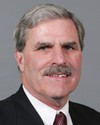Thank you, Mr. Chairman, committee members. I am very pleased to be appearing once again before you today.
My name is Ron Moran. I'm the National President of the Customs Excise Union Douanes Accise, our CEUDA. With me today is CEUDA's National Vice-President, Mr. Jean-Pierre Fortin. We are both employed as border officers for the Canada Border Services Agency and we have a combined 52 years of experience working for border services.
We are pleased to be back here as you focus on issues surrounding the government's decision to provide training and equipment to arm Canada Border Services officers. As you know, arming border guards has long been one of our agency's key demands.
Let me first say that we have been following your committee's deliberations very closely. We understand that your job is to obtain information about issues that are important to you. Therefore, I will keep my preliminary remarks brief, to allow time for as many questions as possible.
For over 22 years, CEUDA has been lobbying the government to arm its members. Furthermore, it has been demanding for more than 26 years that officers no longer work alone. I don't intend to review two decades of history, but I would like to share with you some important information of a general nature concerning the arming of border guards to give you a better understanding of the reasons why CEUDA has taken this stand and why we applaud the government's decision.
In May of 1998, Canada customs services underwent the most significant change in their history. The House of Commons unanimously passed Bill C-18, a Liberal bill that for the first time ever, authorized customs officers to enforce the Criminal Code at points of entry into Canada. Among other things, passage of this bill meant that as customs officers, we could arrest drunk drivers, child molesters, persons in possession of stolen property and any individual in respect of whom law enforcement officials had issued an arrest warrant.
Passage of this bill meant that in practical terms, those individuals representing our country's first line of defence began taking on duties that historically, had been handled only by police officers. It also meant that customs officers became members of the only law enforcement agency in North America to handle this type of arrest, namely criminal arrests -- the most dangerous of all --, without the benefit of a gun for protection.
We have come a long way since then.
Despite initial resistance from management, today officers at just about all points of entry find themselves enforcing the Criminal Code. Not surprisingly, when we were assigned the task of enforcing the Criminal Code it became obvious that there was a tremendous difference between dealing with someone who failed to declare a bottle of wine or a carton of cigarettes versus pulling drunk drivers out of vehicles or wrestling down someone wanted for one crime or another and who has chosen to resist arrest.
As our focus continued to move toward enforcement, we started to interdict serious criminality, including drug and currency smuggling, as well as a significant volume of persons seeking to illegally bring firearms, often fully loaded and ready to go, into Canada. It may surprise some of you to know that between January 2000 and May 2005, for example, 324 times our officers were involved in narcotics and currency seizures of a value of more than $1 million. Those of you familiar with modern organized crime will appreciate that just about every time, the conveyances being used were escorted and monitored by individuals known as enforcers. This means that 324 times during that period, or one and a half times per week, we were the only thing standing between organized crime and $1 million or more of their drugs or their money. You should also know that we seize more weapons than all police forces combined.
Life is such that there are countless situations in which we find ourselves where it is simply impossible to withdraw in accordance with current CBSA policy—which, by the way, means we are supposed to let the danger enter Canada to potentially harm Canadians. Yes, police can be called ahead of time when we know what to expect, but in our business, danger tends to show up unexpectedly, a situation made worse by antiquated lookout systems, which we can discuss further if you wish.
Many of you will know that, in 2005, CEUDA commissioned an independent study of the risks faced by our officers, when we learned that the supposedly independent study, awarded to a company called ModuSpec, had been unilaterally and secretly altered by management in 2003 to remove a recommendation for an armed presence at identified land border crossings.
The choice of the word “altered”, by the way, was that of Liberal Senator Colin Kenny and his committee as a result of their investigations and inquiries of CBSA on this matter.
I hope you can imagine how outraged the officers were to learn of such dishonesty, which, in our minds, equated to playing Russian roulette with the lives of our members. It was one thing for the government to bury its head in the sand over the need for arming the border, but it was quite another to be burying evidence just because this evidence didn't agree with the position taken.
The president of the Northgate Group, which is the company that we had retained, is appearing before you today and can answer your questions, but I can say that its methodology, scope, and analysis were patently, incomparably superior to the altered ModuSpec report. We posted the Northgate report—unedited, I might add—on our website and gave a copy to pretty much anyone who was prepared to read it.
CEUDA has continued to survey its members, and our response rates are very high: 91% on the subject of individual officers' wishes regarding sidearms; and 100% on the land border port of entry site survey.
I would be happy to share the results in detail with you, but they demonstrate two key points, with which I will close my remarks.
We surveyed 2,400 officers who work at land border crossings, and we obtained a response rate of, as I've stated, 91%. The question to them was, do front line officers want, or feel that there is a need for, sidearms? Of the 2,200 officers who responded, 88% want a sidearm, and an additional 10% who don't personally want a sidearm agree that the job requires one.
Another question asked of the officers was, do police respond quickly to calls from our members at the border? Our members have told us, time and time again, that in just about every instance the answer is a firm no. The opposition spin, backed by no evidence, has by contrast always been yes.
We asked our good friends at CBSA about this via an access to information request. We are still sorting through the response--the disorganized response, frankly--which numbers in the thousands of pages, but we can nonetheless confirm the following.
Information was provided for only 178 of the 1,065 points of entry serviced by CBSA, and of those, CBSA could not provide known distance to a police detachment for 62 locations. Of a total of 119 land border points of entry, 37 had police response times in the range of two hours or more.
Contrary to assertions from CBSA, there are no individual agreements with ports of entry and local police in relation to pursuit and apprehension of persons running the port, and we understand that even the unreliable CBSA data show approximately 900 such runners each year, with an unacceptably low rate being apprehended.
Also worth noting is the fact that hundreds of persons every year for whom arrest warrants are outstanding are released into Canada by CBSA officers because the police are unable to respond.
In closing, CEUDA salutes the government and MPs who have chosen to provide the protection of our members, which is clearly overdue. Equally, it is long past time that Canadians were not put at risk because of the CBSA policy to let known danger enter Canada rather than interdict it properly, with properly trained, equipped, and resourced enforcement officers, right at the points of entry.
If anyone thinks this is speculation, you may want to talk to Priscilla de Villiers. Her daughter was raped and killed by Jonathon Yeo, a Canadian sex offender who, because he was in violation of his bail, was turned back by U.S. Customs at the border, but he was ordered not stopped by Canada Customs because he had a suicide note and a shotgun in his vehicle. Nina de Villiers would be alive today if our officers were not constrained by such dangerous policies.
Like you, we have serious concerns about both the cost and the delay in getting this initiative completed, and we hope these hearings will contribute at long last to getting that important job done.
Merci beaucoup. Thank you.



